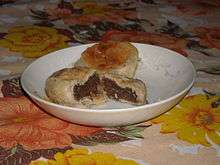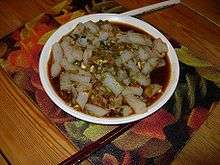Mung bean
The mung bean (Vigna radiata), alternatively known as the moong bean, green gram, or mung[2] Sanskrit मुद्ग / mudga, is a plant species in the legume family.[3][4] The mung bean is mainly cultivated in India, China, and Southeast Asia. It is used as an ingredient in both savory and sweet dishes.
Description
The English word mung is derived from the Hindi word मूंग moong derived from the Sanskrit word मुद्ग (mudga).[5]
Taxonomy
They are one of many species recently moved from the genus Phaseolus to Vigna, and is still often seen incorrectly cited as Phaseolus aureus or Phaseolus radiatus.
Uses
Mung beans are commonly used in various cuisines across Asia.
Whole beans and mung bean paste
Whole cooked mung beans are generally prepared from dried beans by boiling until they are soft. Mung beans are light yellow in colour when their skins are removed.[3] Mung bean paste can be made by dehulling, cooking, and pulverizing the beans to a dry paste.[3]
Although whole mung beans are also occasionally used in Indian cuisine, beans without skins are more commonly used; but in Kerala & Tamil Nadu, whole mung beans are commonly boiled to make a dry preparation often served with rice gruel (kanji கஞ்ஞி). Dehulled mung beans can also be used in a similar fashion as whole beans for the purpose of making sweet soups. Mung beans in some regional cuisines of India are stripped of their outer coats to make mung dal. In Tamil Nadu, Telangana and Andhra Pradesh, steamed whole beans are seasoned with spices and fresh grated coconut in a preparation called sundal சுண்டல். In south and north Indian states, mung beans are also eaten as pancakes. They are soaked in water for six to 12 hours (the higher the temperature, the lesser soaking time). Then they are ground into fine paste along with ginger and salt. Then pancakes are made on a very hot griddle. These are usually eaten for breakfast. This provides high quality protein that is rare in most Indian regional cuisines. Pongal or kichdi is another recipe that is made with rice and mung beans without skin. In Kerala, it is commonly used to make the parippu preparation in the Travancore region (unlike Cochin and Malabar, where toor dal, tuvara parippu,துவரப்பருப்பு is used). It is also used, with coconut milk and jaggery, to make a type of payasam.
In Chinese cuisine, whole mung beans are used to make a tángshuǐ, or dessert, otherwise literally translated, "sugar water", called lǜdòu tángshuǐ, which is served either warm or chilled. In Indonesia, they are made into a popular dessert snack called es kacang hijau, which has the consistency of a porridge. The beans are cooked with sugar, coconut milk, and a little ginger.
In Hong Kong, dehulled mung beans and mung bean paste are made into ice cream or frozen ice pops.[3] Mung bean paste is used as a common filling for Chinese mooncakes in East China and Taiwan.[3] Also in China, the boiled and shelled beans are used as filling in glutinous rice dumplings eaten during the dragon boat festival (端午节).[3] The beans may also be cooked until soft, blended into a liquid, sweetened, and served as a beverage, popular in many parts of China.
In the Philippines, ginisáng monggó (sautéed mung bean stew), also known as monggó guisado or balatong, is a savoury stew of whole mung beans with prawns or fish. It is traditionally served on Fridays of Lent, when the majority Roman Catholic Filipinos traditionally abstain from meat. Variants of ginisáng monggó may also be made with chicken or pork.
Mung bean paste is also a common filling of pastries known as hopia (or bakpia) popular in Indonesia, the Philippines and further afield in Guyana (where it is known as black eye cake) and originating from southern China.
 Ginisang monggo (mung bean soup) with shrimp, served with smoked fish and tomato
Ginisang monggo (mung bean soup) with shrimp, served with smoked fish and tomato- Ginisang monggo with ampalaya and shrimp
- Indian mung dal
- Mung bean dessert
 Hopia filled with mung bean paste
Hopia filled with mung bean paste Mung-bean fry
Mung-bean fry
Bean sprouts
Mung bean are germinated by leaving them in water for four hours of daytime light and spending the rest of the day in the dark. Mung bean sprouts can be grown under artificial light for four hours over the period of a week. They are usually simply called "bean sprouts". However, when bean sprouts are called for in recipes, it generally refers to mung bean or soybean sprouts..
Mung bean sprouts are stir-fried as a Chinese vegetable accompaniment to a meal, usually with garlic, ginger, spring onions, or pieces of salted dried fish to add flavour. Uncooked bean sprouts are used in filling for Vietnamese spring rolls, as well as a garnish for phở. They are a major ingredient in a variety of Malaysian and Peranakan cuisine, including char kway teow, hokkien mee, mee rebus, and pasembor. In Korea, slightly cooked mung bean sprouts, called sukjunamul (hangul: 숙주나물), are often served as a side dish. They are blanched (placed into boiling water for less than a minute), immediately cooled in cold water, and mixed with sesame oil, garlic, salt, and often other ingredients. In the Philippines, mung bean sprouts are made into lumpia rolls called lumpiang togue. In Indonesia the food are often used as fillings like Tahu Isi (stuffed tofu) and complimentary ingredient in many cookings such as rawon and soto.
In northern China and Korea, soybean sprouts, called kongnamul (hangul: 콩나물) in Korean, are more widely used in a variety of dishes. Don't use the 'blue sprouts' since they contain a little bit of Hydrogen cyanide, like potatosprouts do.
Starch
Mung bean starch, which is extracted from ground mung beans, is used to make transparent cellophane noodles (also known as bean thread noodles, bean threads, glass noodles, fensi (粉絲), tung hoon (冬粉), miến, bún tàu, or bún tào). Cellophane noodles become soft and slippery when they are soaked in hot water. A variation of cellophane noodles, called mung bean sheets or green bean sheets, are also available. In Korea, a jelly called nokdumuk (hangul: 녹두묵; also called cheongpomuk; hangul: 청포묵) is made from mung bean starch; a similar jelly, colored yellow with the addition of gardenia coloring, is called hwangpomuk (hangul: 황포묵). In northern China, mung bean jelly is called liangfen (凉粉, meaning chilled bean jelly), which is very popular food during summer. Jidou liangfen is another flavor of mung bean jelly food in Yunnan, in southern China.
Mung batter is used to make crepes named pesarattu in Andhra Pradesh, India and pancakes named Bindaetteok in Korea.
 Chinese mung bean jelly in chili sauce
Chinese mung bean jelly in chili sauce
History of domestication and cultivation

The mung bean was domesticated in Persia (Iran), where its progenitor (Vigna radiata subspecies sublobata) occurs wild.[6][7] Archaeology has turned up carbonized mung beans in many sites in India.[8] Areas with early finds include the eastern zone of the Harappan civilization in Punjab and Haryana, where finds date back about 4500 years, and South India in the modern state of Karnataka where finds date back more than 4000 years. Some scholars therefore infer two separate domestications in the northwest and south of India. In South India there is evidence for evolution of larger-seeded mung beans 3500 to 3000 years ago.[7] By about 3500 years ago mung beans were widely cultivated throughout India. Cultivated mung beans later spread from India to China and Southeast Asia. Archaeobotanical research at the site of Khao Sam Kaeo in southern Thailand indicates that mung beans had arrived in Thailand by at least 2200 years ago.[9] Finds on Pemba Island indicate that during the era of Swahili trade, in the 9th or 10th century, mung beans also came to be cultivated in Africa.[10]
Common names
Mung beans are known under a variety of names in different languages:
- Amharic: masho? (ማሾ)
- Arabic: maash (ماش)
- Assamese: mugu dali, mogu dail
- Bengali: mug (মুগ), mug dal, mung, or mongo
- Irish: "pónaire mung"
- 绿豆/綠豆 (Pinyin: lǜdòu, Jyutping: luk6dau6, means "green bean")
- Bulgarian: папуда (papuda [pʌˈpu.dʌ])
- Burmese: pe nauk (ပဲနောက်) or pe ti (ပဲတီ)
- Cebuano: munggus
- Chamorro: munggo
- East Timor: monggo or munggo
- Greek: rovitsa (ροβίτσα)
- Gujarati: mag (મગ)
- Hebrew: mash (מש)
- Hindi: mūṅg (मूँग)
- Indonesian: kacang hijau or kacang ijo (Javanese), "green beans"
- Japanese: 緑豆 (ryokutō, means "green bean") or 青小豆 (aoazuki, means "green azuki")
- Kannada: hesaru kaalu (ಹೆಸರು ಕಾಳು)
- Korean language: nokdu (녹두)
- Malay: kacang hijau
- Malayalam: cherupayar or cheru payaru (ചെറുപയർ)
- Marathi: 'मुग डाऴ, moog, moong, or mongo
- Pali: mugga
- Pashto: mai (مۍ)
- Persian: maash (ماش)
- Portuguese: feijão-mungo or feijão-da-china
- Punjabi: moongi
- Sanskrit: mudga (मुद्ग)
- Shingazidja: ntsandzi
- Sinhalese: mung aeta (මුං ඇට)
- Spanish: frijol mungo or poroto chino
- Swahili: choroko or ndengu
- Tagalog: monggo or munggo (ᜋᜓᜅ᜔ᜄᜓ)
- Tamil:pachaippayaru (பச்சைப்பயறு), pāciparuppu (பாசிபருப்பு)
- Telugu: pesara (పెసర)
- Thai: thua khiao (ถั่วเขียว; "green bean")
- Turkish: mash fasulyesi (maş)
- Urdu: moong or maash (ماش) or (مونگ)
- Vietnamese: đậu xanh (means "green bean")
Mung bean sprouts are known as the following:
- Burmese: pe ti pin pauk (ပဲတီပင်ပေါက်)
- 芽菜 (poj: gê-tshài, means "sprout vegetable"), or 银芽/銀芽 (poj: gûn-gê, means "silver sprouts"), and 豆芽 (poj: tāu-gê)
- Dutch: taugé
- Cebuano: togé
- French language: "fèves germées"
- Hokkien: tāu-gê
- Indonesian: tauge or kecambah
- Japanese: もやし (moyashi, means "sprouted")
- Korean: sukju namul
- Malay: tauge
- Portuguese: moyashi (from Japanese) or brotos-de-feijão
- Singlish: tauge
- Sinhala: mung biija (මුo බීජ)
- Spanish: frijolitos chinos or diente de dragón
- Tagalog: togé
- Thai: thua-ngok (ถั่วงอก)
- Turkish: mash filizi (maş)
- Vietnamese: giá đậu xanh (means "green bean sprout"), giá đậu or giá đỗ
- Sindhi: Mungh(منڱ)'
See also
References
- ↑ "The Plant List: A Working List of All Plant Species". Retrieved 13 January 2015.
- ↑ According to the Oxford English Dictionary, 2nd ed., the main spelling in English is "mung", but moong is also used, and mungo is recorded. "Bean" is not always appended. They are often sold as "moong".
- 1 2 3 4 5 6 Brief Introduction of Mung Bean. Vigna Radiata Extract Green Mung Bean Extract Powder Phaseolus aureus Roxb Vigna radiata L R Wilczek. MDidea-Extracts Professional. P054. http://www.mdidea.com/products/proper/proper05402.html
- ↑ "The World's Fastest Dictionary". Vocabulary.com. Retrieved 2011-06-29.
- ↑ "Mung bean | Define Mung bean at Dictionary.com". Dictionary.reference.com. Retrieved 2012-08-22.
- ↑ Tomooka, N.; Vaughan, D. A.; Moss, H.; Mixted, N. (2003). The Asian Vigna: genus Vigna subgenus Ceratotropis genetic resources. New York: Kluwer.
- 1 2 Fuller, D. Q. (2007). "Contrasting patterns in crop domestication and domestication rates: recent archaeobotanical insights from the Old World". Annals of Botany. 100 (5): 903–924. doi:10.1093/aob/mcm048. PMC 2759199
 . PMID 17495986.
. PMID 17495986. - ↑ Fuller, D. Q.; Harvey, E. (2006). "The archaeobotany of Indian Pulses: identification, processing and evidence for cultivation". Environmental Archaeology. 11 (2): 219–246. doi:10.1179/174963106x123232.
- ↑ Castillo, Cristina; Fuller, Dorian Q. (2010). "Still too fragmentary and dependent upon chance? Advances in the study of early Southeast Asian archaeobotany". In Bellina, B.; Bacus, E. A.; Pryce, O.; et al. 50 Years of Archaeology in Southeast Asia: Essays in Honour of Ian Glover. Bangkok/ London: River Books. pp. 91–111. ISBN 9786167339023.
- ↑ Walshaw, S. C. (2010). "Converting to rice: urbanization, islamization and crops on Pemba, AD 700-1500". World Archaeology. 42: 137–154. doi:10.1080/00438240903430399.
External links
| Wikimedia Commons has media related to Vigna radiata. |
- "mung bean Vigna radiata". Integrated Taxonomic Information System.
- "mung bean Vigna radiata var. radiata". Integrated Taxonomic Information System.
| Wikispecies has information related to: Vigna radiata |
- How to make mung bean sprouts at home easy way - clean and safe

